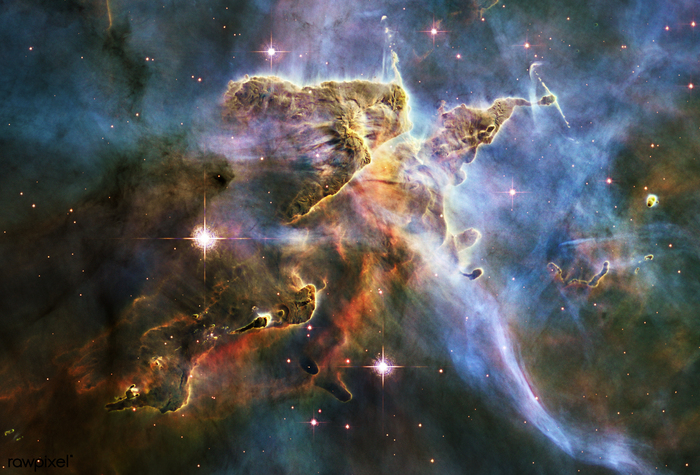Sunday after lunch. It's cold outside, better to stay warm on the sofa, under the blanket. I don't see it directly, but the rays of the evening sun enter through the window and I think: “the amount of dust in the air”. Flashes happen everywhere, I can see floating in the air the dust motes that normally go unnoticed and that surround us anywhere, especially in a closed one. I even see the turbulence in the dust if my daughter runs across the room, or how the specks rise because of the convective current created by the radiator.
There's a lot of physics in that picture that I think we've all seen before, from fluid dynamics to statistical physics to describe the velocity distribution of dust motes. But today I want to focus on two aspects that are exactly the same as what astrophysicists use to study how planets form (and the stars that host them) and that have to do, how could it be otherwise, with light.
First physical concept: the rays of light from that sun that I cannot see hit the dust motes and are reflected by them. They were rays that would never have reached my eyes, but the dust redirects them towards me. This is called light dispersion, "scattering" in English. Each speck of dust behaves like a small mirror, although quite imperfect because it does not reflect all the light, part of it absorbs it. And that brings us to the second physical concept: those sun rays, that energy, is also partly absorbed by the dust motes and heats them up. Like any body at a certain temperature, dust emits light. But that light is quite different from the one that has come from the Sun, the dust is a "radiation transformer", although the photons emitted by the dust depend on how they were heated. The photons that the dust creates are not perceptible by our eyes,they are infrared photons that everything around us is emitting to a greater or lesser extent. So it's a good thing we don't "see" infrared photons, because they would blind us, too much radiation to distinguish something concrete.
planet formation
So far the physics of walking around the house, never better said. Now, what does all this have to do with planet formation and astrophysics? Well, exactly with the same physical processes is how we study the planetary systems in formation, the so-called protoplanetary disks (known as proplyds, for its abbreviation in English), and also the formation of the star or stars that reign in those systems. Stars first and then planets (or simultaneously) form in gas clouds that also contain interstellar dust. This consists mainly of what are known as silicates and carbon-containing molecules such as polycyclic aromatic hydrocarbons (PAHs) or graphite. They seem like very rare compounds, but just from the name,because silicates account for more than 90% of the earth's crust; PAHs surround us when something burns, for example, wood in a barbecue or the meat itself in a kitchen, or they are also found in the smoke from car exhaust pipes; and graphite, that we do have more control over, we know that it is used for pencils but also for bearings, industrial lubricants or in nuclear reactors.
Returning to the protoplanetary disks, the interstellar dust specks give rise to the planets, although things are not simple, along the way the PAHs and many of the carbon molecules are usually lost, the cloud transforms into a disk,...! And a lot of dust has to collect to form a planet, like the fluff in the corners of the house! The dust on the disks are initially about the same size, a few microns (as big as a bacterium or a red blood cell), and they scatter light just like the dust motes in our house (the composition is usually very different, in our small pieces of skin, hair, clothing,...) dominate the house). They also get hot, although their typical temperature is well below that of our houses, about -200 to -250 degrees Celsius.
Sometimes protoplanetary disks are so dense that they do not reveal the light of the unborn or already formed star itself, which is in the center of the disk and whose gravity and radiation dominate the behavior of the disk.
But the study of the light scattered by the dust allows us to know what that star or star project is like.
It is like on our sofa, we did not see the Sun but part of its light came to us reflected by the dust motes.
spitzer
All this physics that I'm talking about is what we've been using for a couple of decades now to study how planets form. We start with ground-based observations, which are very limited because the infrared radiation from astronomical objects is vastly weaker than the infrared light emitted by everything around us on our planet, and because our atmosphere is opaque to part of the infrared spectrum. So we had to send observatories into space, like Spitzer, a small telescope only 80 centimeters in diameter, which, however, being at a temperature of minus 240 degrees Celsius, was extremely sensitive to thermal emission from interstellar dust. With the Hubble Space Telescope we discovered the so-called proplyds in the famous Orion nebula,where thousands of stars are forming right now, with their protoplanetary disks around. With Spitzer, by means of the infrared emission of the dust, we were able to study its composition, detecting the aforementioned silicates, and also water, carbon dioxide or methanol ice, which paradoxically was used to prevent the water from freezing in our cars.
Spitzer was a small telescope, even smaller than what many amateur astronomers use every night. Today the James Webb Space Telescope, which is normally identified with the heir to Hubble (not its replacement) and not so much to Spitzer even though it is, is going to allow us to study the infrared light coming from planetary systems in formation in a much more detailed way. . This will be thanks to its size 8 times larger than Spitzer and its temperature, which although it is somewhat higher than Spitzer's, will still make it possible to observe a myriad of planetary systems in different stages of their evolution that will allow us to reconstruct a history of our own Solar system. All this with physics that we can learn from our sofa while we imagine journeys of knowledge through the universe, keeping ourselves warm, yes.
Pablo G. Pérez González
is a researcher at the Center for Astrobiology, dependent on the Higher Council for Scientific Research and the National Institute for Aerospace Technology (CAB/CSIC-INTA).
Cosmic Void
is a section in which our knowledge about the universe is presented in a qualitative and quantitative way. It is intended to explain the importance of understanding the cosmos not only from a scientific point of view but also from a philosophical, social and economic point of view. The name "cosmic vacuum" refers to the fact that the universe is and is, for the most part, empty, with less than one atom per cubic meter, despite the fact that in our environment, paradoxically, there are quintillion atoms per meter cubic, which invites us to reflect on our existence and the presence of life in the universe. The section is made up of
Pablo G. Pérez González
, researcher at the Center for Astrobiology;
Patricia Sanchez Blazquez
, full professor at the Complutense University of Madrid (UCM);
and
Eva Villaver
, researcher at the Center for Astrobiology.
You can follow
MATERIA
on
,
and
, or sign up here to receive
our weekly newsletter

/cloudfront-eu-central-1.images.arcpublishing.com/prisa/FD6WW3X57JDOZG5NBPBU7HDDBY.jpg)












/cloudfront-eu-central-1.images.arcpublishing.com/prisa/EXJQILQR5QI7OMVRTERD7AEZAU.jpg)
